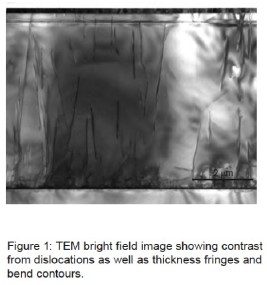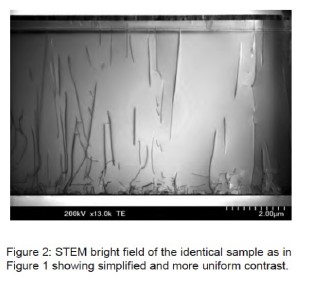Evaluation of Dislocation Type in GaN Using STEM
Home » Evaluation of Dislocation Type in GaN Using STEM
With the rapid development of LEDs, the demand for LED devices has become stricter. Previous studies have shown that the type of threading dislocation has a strong effect on device IQE, so it is necessary to determine the type of dislocation efficiently and quickly.
Evaluation of dislocation type in GaN using STEM (AN463)
Conventionally, dislocation evaluation of various materials has been performed by general TEM analysis using cross-sectional samples. However, in TEM observation, as shown in Fig. 1, there are many interference fringes due to thickness differences and interference fringes caused by bending, which can complicate analysis. The STEM image corresponding to Fig. 1 is shown in Fig. 2. It can be seen that the contrast of dislocations can be confirmed very simply in the STEM image comparing the two. Also, dislocation type information can be acquired at the same time.

By using a specific sample inclination, threading dislocation in cross-sectional observation can be classified into forms such as edge dislocations, screw dislocations, and mixed dislocations. Fig. 3 shows an example of observation in an orientation that emphasizes the edge dislocation (e), while Fig. 4 shows an example of observation in an orientation that emphasizes the screw dislocation (s). The dislocations highlighted and observed in both Fig. 3 and Fig. 4 are thought to be mixed dislocations (m) with both edge dislocations and screw dislocations.


Would you like to learn more about GaN Using STEM?
Contact us today for your GaN Using STEM needs. Please complete the form below to have an EAG expert contact you.